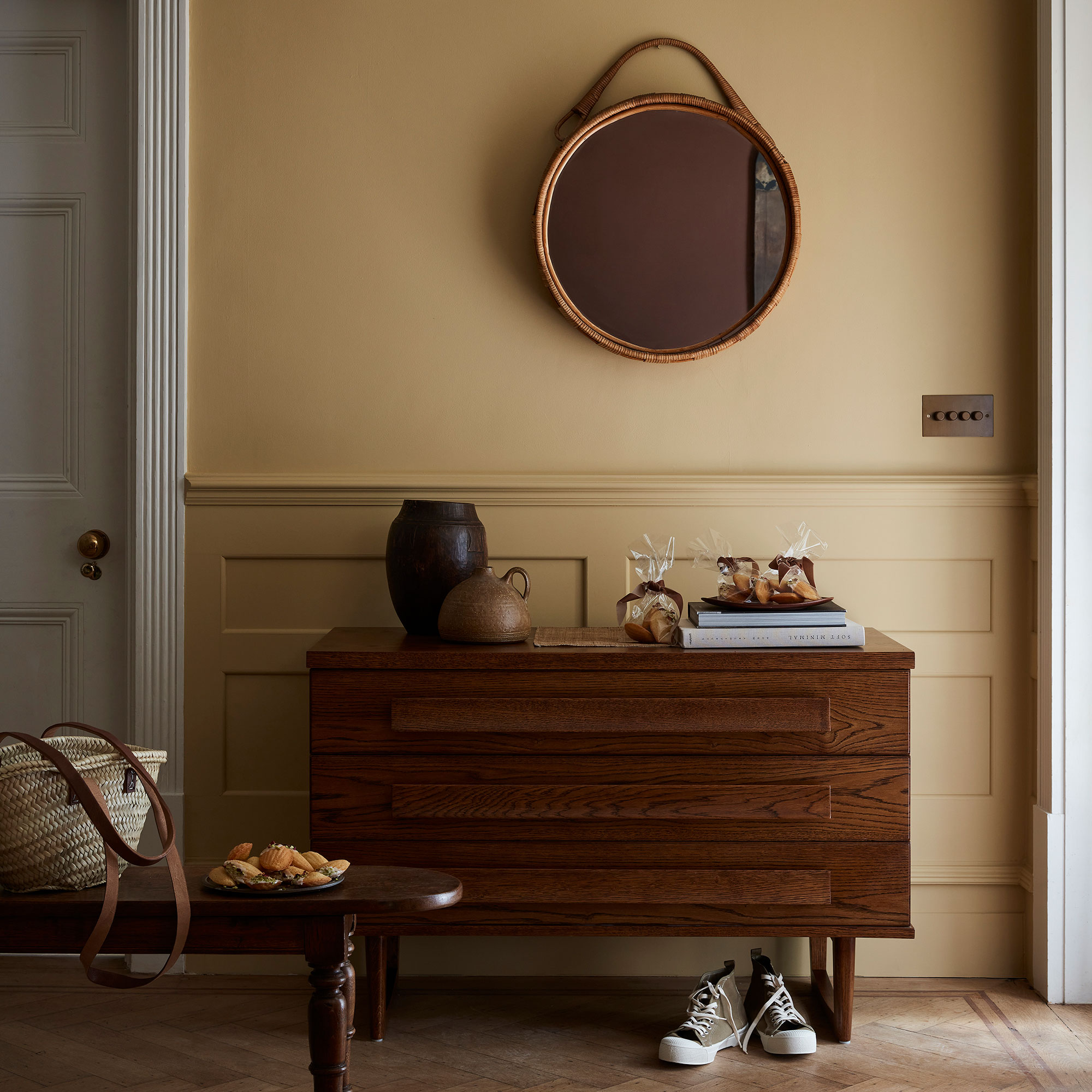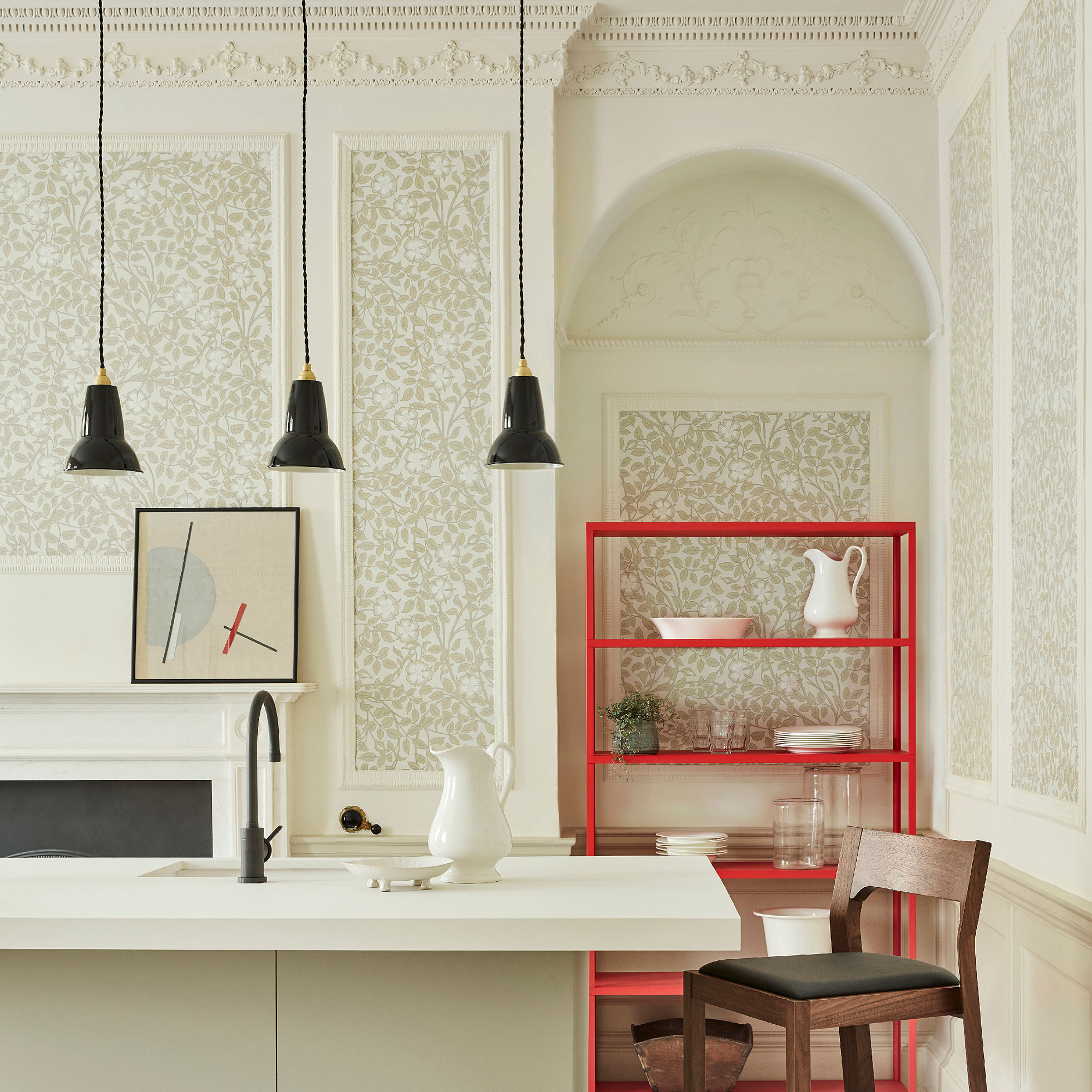
Woodwork no longer needs to be painted in simple shades of white or cream. More and more designers and homeowners are choosing to move away from traditional colour combinations in favour of bold and bright shades, and why not? The colour that you choose for your woodwork has a big impact, after all, it’s in every room in your home, so what’s best for your space? Should woodwork be lighter or darker than walls? Should you paint everything the same colour? Or is creating a contrast better?
Updating your woodwork is a fairly sizable task, so it’s important to make the right choice to create the look you want to achieve. If you wish to go bold with colour, make your rooms look bigger and brighter, or highlight the original features in your property, the colour of your woodwork is key.
With so many options, it’s easy to feel overwhelmed and end up on the fence about which colour to choose. To make the decision easier, we’re exploring the visual effect of going for lighter or darker woodwork to help you find the perfect balance.
Should woodwork be lighter or darker than walls?
The truth is, there is no simple answer to this question as it really depends on the look that you want to achieve. The good news is that once you understand how the colour of your woodwork impacts your space, you can make an informed decision to create the perfect finish and achieve the look you desire.
‘There is a distinct move away from the more traditional approach of painting woodwork and skirtings in stark white, in favour of more creative, contrasting or coordinating colours,’ explains Ruth Mottershead, Creative Director at Little Greene.

‘Consider coordinating with wallpaper or incorporating a bold colour highlight on skirting or a picture rail,’ Ruth continues. ‘Painting woodwork in a darker colour will dramatically highlight architectural details, whereas painting it in a lighter shade will create more of a nuanced detail. For a scheme with real impact, use one colour across walls and woodwork to create a wraparound, colour-drenched scheme.’
From bright pops of colour and neutrals to colour drenching and colour blocking, let’s look into everything you need to know to choose the paint colour for your woodwork.
The visual effect of painting woodwork lighter than the walls
Painting woodwork lighter than the walls is generally the go-to when it comes to freshening up our interiors. This is a great option if your rooms are on the small side, or your ceilings are a little low, as lighter woodwork will create a sense of height and space and will instantly brighten up the room.
‘White comes in many nuances and hues,’ explains Ruth Mottershead of Little Greene. ‘Instead of opting for a bright white on woodwork, which can create a very strong contrast and appear quite stark, consider a neutral-warm white for a calm interior - this will add a softly spoken depth to an interior.’

If you are painting your walls a dark and rich colour, lighter woodwork will create a contrast and will draw the eye to your skirting boards and door frames. This is ideal if your property has original features and you want to highlight these. Be aware though that in painting woodwork significantly lighter than the walls, this may make your ceilings look lower as visually the wall will finish at the top of the skirting, cutting it off a few inches short.
Lighter woodwork doesn’t have to mean white woodwork though, instead consider pale colours that compliment your walls. Light shades are also a great option if you’re going for dark walls, but want to add interest to the space. This look will work particularly well if you have high ceilings and beautifully detailed woodwork.
The visual effect of painting woodwork darker than the walls
Instead of painting your walls in a deep shade and your woodwork lighter, turn the concept on its head. A bold shade on the woodwork will add a touch of colour to your space. Your woodwork presents a fantastic opportunity to introduce colour without having too much of it. This works particularly well in smaller rooms where painting all of the walls in a darker colour might absorb too much light. Instead, opt for a pale colour on your walls, and a darker bolder colour on the woodwork.
‘Using a darker tone of paint on all of your woodwork, including doors and windows, is more practical than the typical white in high traffic areas such as hallways,’ explains Verity Coleman, founder and creative director of design studio Rascal & Roses.

‘Alongside this, rich tones will also add warmth and depth. I find bright white on woodwork to be a little jarring. Choosing a dark colour means that you can spatially maximise the visual appearance of the room, as things will always look bigger in pale neutrals. By using colours on your woodwork, you can enhance the size of the room, but still have fun with your paint colours.’
Schemes that use deep and strong colours are a real statement, but darker shades are more impactful when contrasted with lighter shades. Introducing a lighter secondary colour creates balance and stops the bold colour from being too overbearing. If your scheme is otherwise simple, painting the woodwork darker will add drama to the space.
When you paint your woodwork darker than your walls, you can frame certain parts of the room too, adding more detail and contrast. If you prefer neutrals, choose a neutral colour that’s a couple of shades darker than your walls for your woodwork. This creates the same look without being too dramatic.
Can you paint woodwork the same colour as the walls?
When you paint your woodwork the same colour as your walls your space will instantly feel bigger and your ceiling height taller. This is because you’re not drawing attention to the woodwork, making it blend seamlessly into the walls so that there’s no divide breaking up the room. This is true no matter what colour you paint your space. If your room is big and has high ceilings, try a colour-drenching paint idea using the same shade across your woodwork, walls and ceiling for a dramatic look.

Painting everything the same colour is a bold look. If you want to soften it, try breaking the scheme up with different shades from the same colour palette. ‘Consider layering different strengths of the same hue within a room,’ suggests Ruth from Little Greene.
‘The sophisticated warm neutral ‘Green Stone’ works fantastically alongside the coordinating ‘Green Stone’ Colour Scales family, making it a versatile and easy to use palette for creating a harmonious and considered interior. Opting for a lighter colour across woodwork will put the emphasis onto the walls and create a feeling of depth.’
What to consider to help you find the perfect balance
1. The size of the room

If your rooms are on the small side or you have low ceilings, painting all of the woodwork in the same shade will help to reduce ‘visual clutter’ making the room appear more spacious. Take this one step further and paint the walls and ceilings in the same shade.
Sue Kim, director of colour marketing at Valspar adds, ‘For a trendy look, incorporate an energising hue like a bold blue by purposely placing the colour throughout the room on surfaces like the door and window mouldings which provides a contemporary feel, this can also make a room feel larger and more spacious.’
If you prefer neutrals, consider grey instead of white and add depth with other colours that go with grey. For larger rooms, you’ve got a bit more creative freedom - almost anything goes. Darker shades, contrasting woodwork and light or dark tones will all work well.
2. The amount of natural light

It’s well worth considering the amount of natural light that your room gets to help you decide whether to paint woodwork darker or lighter, or the same colour as the walls. Bright rooms can take almost any colour combination, whereas north-facing rooms would benefit from a lighter, warmer colour palette.
‘Rooms soaked in sunlight look beautiful in rich colours, so homeowners can experiment with dark walls and lighter woodwork,’ advises Bailey Oates, Colour Expert at Earthborn. ‘For rooms with less natural lighting, homeowners may want to consider a light, neutral tone to maintain an airy feel and harmonious flow.’
3. The purpose of the room

How you use your room and the time of day that you are in there will impact your colour choices. For example, in snugs and living rooms you might want to create a cosy, cocooned feel, making colour drenching in dark rich shades a good option.
Bailey Oats from Earthborn adds, ‘When painting woodwork in a small room or one with low ceilings, using a lighter colour than the walls will create the sense of a larger, airy space. This works really well in bathrooms and kitchens as the lighter tones open up a room and create an energising atmosphere. An eggshell paint will provide a stylish soft sheen finish that bounces natural light around the room,’ Bailey adds.
4. The finish and style of your woodwork

If you live in a period property with large and highly detailed skirting boards, wide door frames or beautiful panelling, you might want to consider drawing more attention to these original features. This can easily be done by painting your woodwork either lighter or darker than the walls - anything that creates a contrast will work well. If your skirting is more functional than it is decorative, painting it the same colour or just slightly darker or lighter than your walls is a good option.
FAQs
Should skirting boards be lighter or darker than walls?
Typically, skirting boards are painted a shade lighter than the walls to create a sense of height and space in the room. This can be particularly helpful if your home features small rooms and low ceilings. However, there are no rules when it comes to choosing paint colours for skirting boards, but it’s worth being aware of the impact of the colour that you choose on how your space looks and feels.
Should trim be the same colour throughout the house?
Where possible, paint your woodwork the same colour throughout your house as this will act as a link for your entire scheme, tying each room together with one colour that’s carried through the whole house. Generally speaking, skirting boards and architraves should be painted the same colour too, however you could consider painting them in different shades if you want to achieve a quirky or maximalist look.







